radiator CHEVROLET CAMARO 1967 1.G Chassis User Guide
[x] Cancel search | Manufacturer: CHEVROLET, Model Year: 1967, Model line: CAMARO, Model: CHEVROLET CAMARO 1967 1.GPages: 659, PDF Size: 114.24 MB
Page 70 of 659
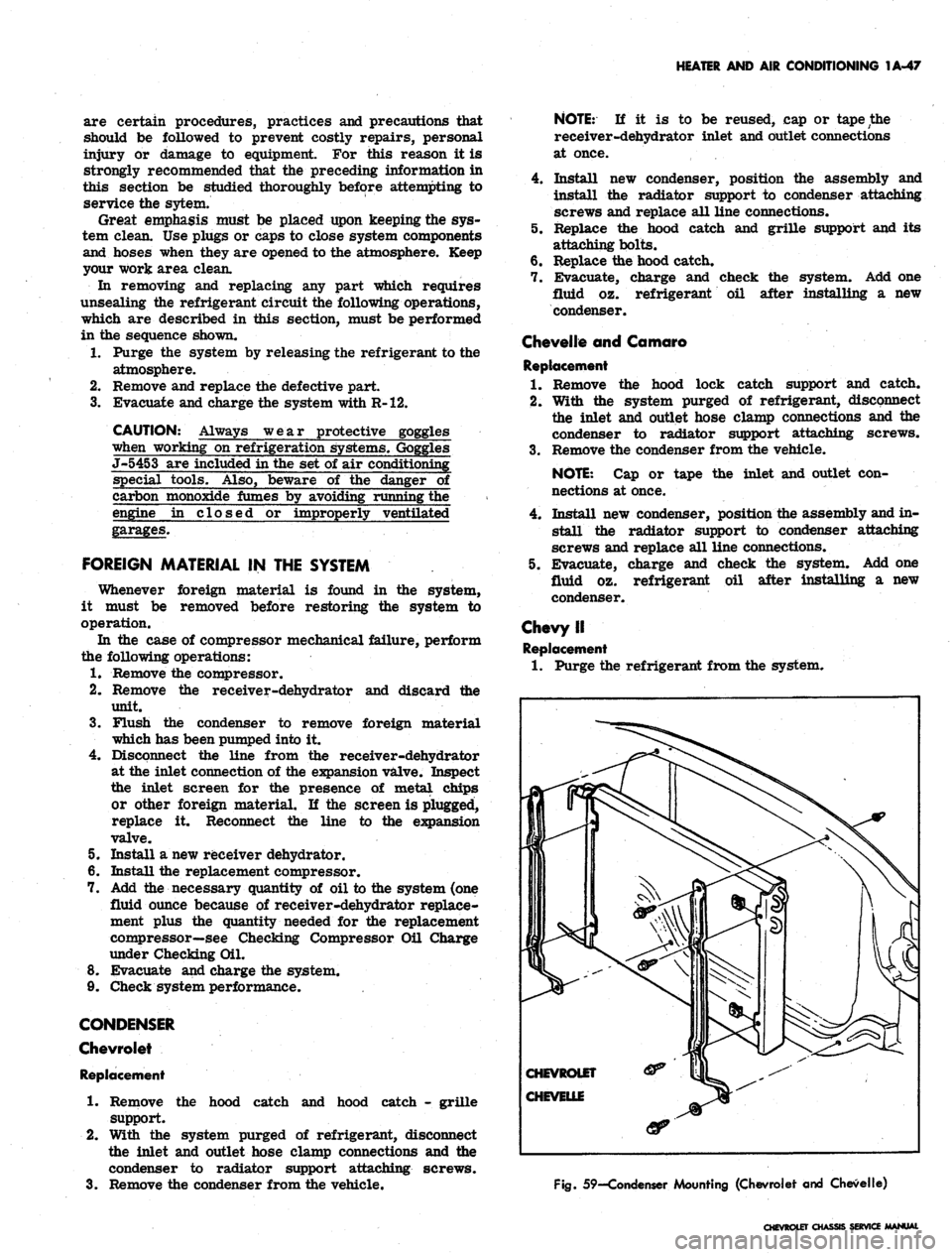
HEATER AND AIR CONDITIONING 1A-47
are certain procedures, practices and precautions that
should be followed to prevent costly repairs, personal
injury or damage to equipment. For this reason it is
strongly recommended that the preceding information in
this section be studied thoroughly before attempting to
service the sytem.
Great emphasis must be placed upon keeping the sys-
tem clean. Use plugs or caps to close system components
and hoses when they are opened to the atmosphere. Keep
your work area clean.
In removing and replacing any part which requires
unsealing the refrigerant circuit the following operations,
which are described in this section, must be performed
in the sequence shown.
1.
Purge the system by releasing the refrigerant to the
atmosphere.
2.
Remove and replace the defective part.
3.
Evacuate and charge the system with R-12.
CAUTION: Always wear protective goggles
when working on refrigeration systems. Goggles
J-5453 are included in the set of air conditioning
special tools. Also, beware of the danger of
carbon monoxide fumes by avoiding running the
engine in closed or improperly ventilated
garages.
FOREIGN MATERIAL IN THE SYSTEM
Whenever foreign material is found in the system,
it must be removed before restoring the system to
operation.
In the case of compressor mechanical failure, perform
the following operations:
1.
Remove the compressor.
2.
Remove the receiver-dehydrator and discard me
unit.
3.
Flush the condenser to remove foreign material
which has been pumped into it.
4.
Disconnect the line from the receiver-dehydrator
at the inlet connection of the expansion valve. Inspect
the inlet screen for the presence of metal chips
or other foreign material. If the screen is plugged,
replace it. Reconnect the line to the expansion
valve.
5. Install a new receiver dehydrator.
6. Install the replacement compressor.
7. Add the necessary quantity of oil to the system (one
fluid ounce because of receiver-dehydrator replace-
ment plus the quantity needed for the replacement
compressor—see Checking Compressor Oil Charge
under Checking Oil.
8. Evacuate and charge the system.
9. Check system performance.
CONDENSER
Chevrolet
Replacement
1.
Remove the hood catch and hood catch - grille
support.
2.
With the system purged of refrigerant, disconnect
the inlet and outlet hose clamp connections and the
condenser to radiator support attaching screws.
3.
Remove the condenser from the vehicle.
NOTE:
If it is to be reused, cap or tape the
receiver-dehydrator inlet and outlet connections
at once.
4.
Install new condenser, position the assembly and
install the radiator support to condenser attaching
screws and replace all line connections.
5. Replace the hood catch and grille support and its
attaching bolts.
6. Replace the hood catch.
7. Evacuate, charge and check the system. Add one
fluid oz. refrigerant oil after installing a new
condenser.
Chevelle and Camaro
Replacement
1.
Remove the hood lock catch support and catch.
2.
With the system purged of refrigerant, disconnect
the inlet and outlet hose clamp connections and the
condenser to radiator support attaching screws.
3.
Remove the condenser from the vehicle.
NOTE:
Cap or tape the inlet and outlet con-
nections at once.
4.
Install new condenser, position the assembly and in-
stall the radiator support to condenser attaching
screws and replace all line connections.
5. Evacuate, charge and check the system. Add one
fluid oz. refrigerant oil after installing a new
condenser.
Chevy II
Replacement
1.
Purge the refrigerant from the system.
Fig.
59—Condenser Mounting (Chevrolet and Chevelle)
CHEVROLET CHASSIS SERVICE MANUAL
Page 71 of 659
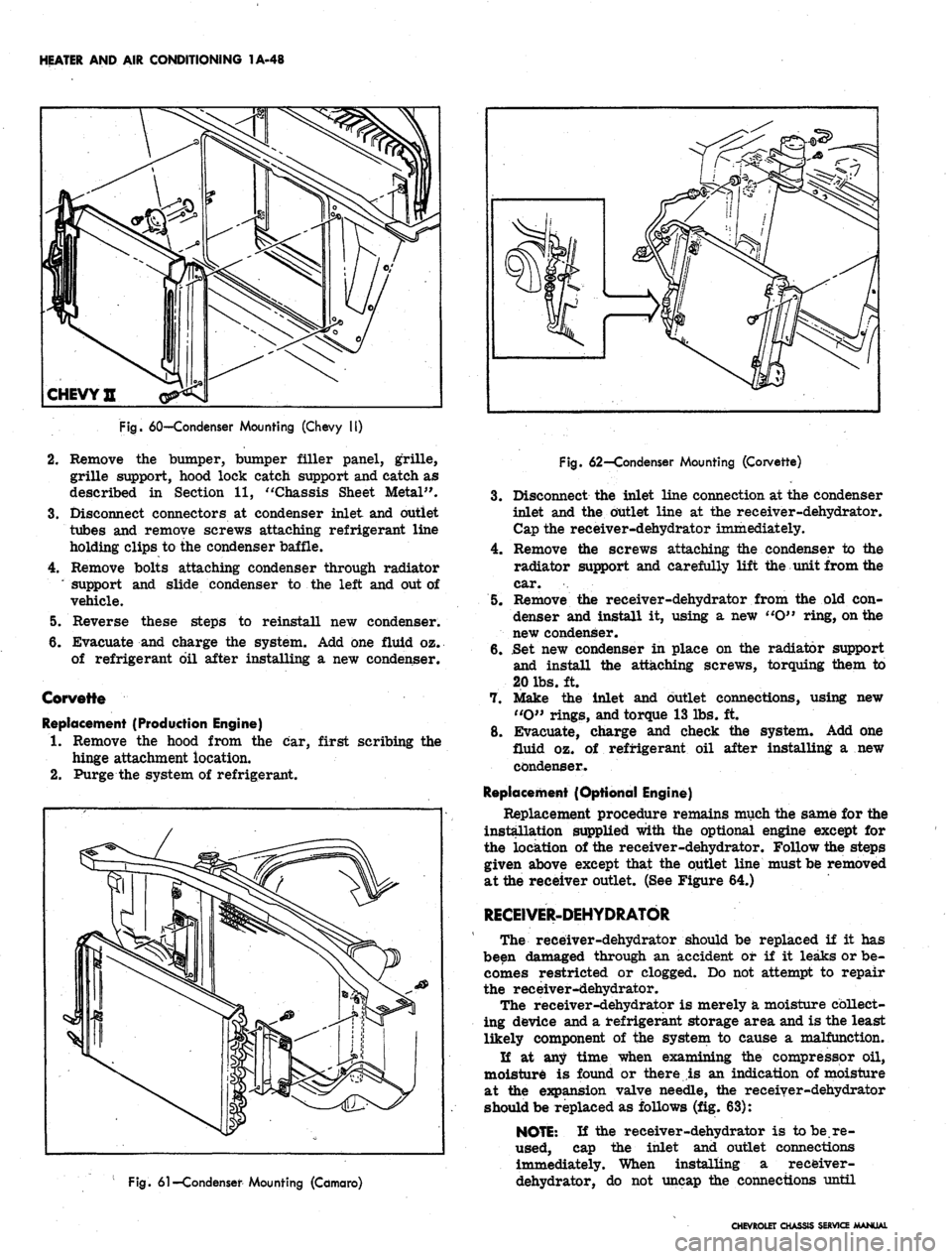
HEATER AND AIR CONDITIONING 1A-48
Fig.
60-Condenser Mounting (Chevy II)
2.
Remove the bumper, bumper filler panel, grille,
grille support, hood lock catch support and catch as
described in Section 11, "Chassis Sheet Metal".
3.
Disconnect connectors at condenser inlet and outlet
tubes and remove screws attaching refrigerant line
holding clips to the condenser baffle.
4.
Remove bolts attaching condenser through radiator
' support and slide condenser to the left and out of
vehicle.
5. Reverse these steps to reinstall new condenser.
6. Evacuate and charge the system. Add one fluid oz.
of refrigerant oil after installing a new condenser.
Corvette
Replacement (Production Engine)
1.
Remove the hood from the car, first scribing the
hinge attachment location.
2.
Purge the system of refrigerant.
Fig.
61—Condenser Mounting (Cdrnaro)
Fig.
62—Condenser Mounting (Corvette)
3.
Disconnect the inlet line connection at the condenser
inlet and the outlet line at the receiver-dehydrator.
Cap the receiver-dehydrator immediately.
4.
Remove the screws attaching the condenser to the
radiator support and carefully lift the unit from the
car.
5. Remove the receiver-dehydrator from the old con-
denser and install it, using a new "O" ring, on the
new condenser.
6. Set new condenser in place on the radiator support
and install the attaching screws, torquing them to
20 lbs. ft.
7. Make the inlet and outlet connections, using new
"O"
rings, and torque 13 lbs. ft.
8. Evacuate, charge and check the system. Add one
fluid oz. of refrigerant oil after installing a new
condenser.
Replacement (Optional Engine)
Replacement procedure remains much the same for the
installation supplied with the optional engine except for
the location of the receiver-dehydrator. Follow the steps
given above except that the outlet line must be removed
at the receiver outlet. (See Figure 64.)
RECEIVER-DEHYDRATOR
The receiver-dehydrator should be replaced if it has
been damaged through an accident or if it leaks or be-
comes restricted or clogged. Do not attempt to repair
the receiver-dehydrator.
The receiver-dehydrator is merely a moisture collect-
ing device and a refrigerant storage area and is the least
likely component of the system to cause a malfunction.
If at any time when examining the compressor oil,
moisture is found or there is an indication of moisture
at the expansion valve needle, the receiver-dehydrator
should be replaced as follows (fig. 63):
NOTE:
If the receiver-dehydrator is to be re-
used, cap the inlet and outlet connections
immediately. When installing a receiver-
dehydrator, do not uncap the connections until
CHEVROLET CHASSIS SERVICE MANUAL
Page 72 of 659
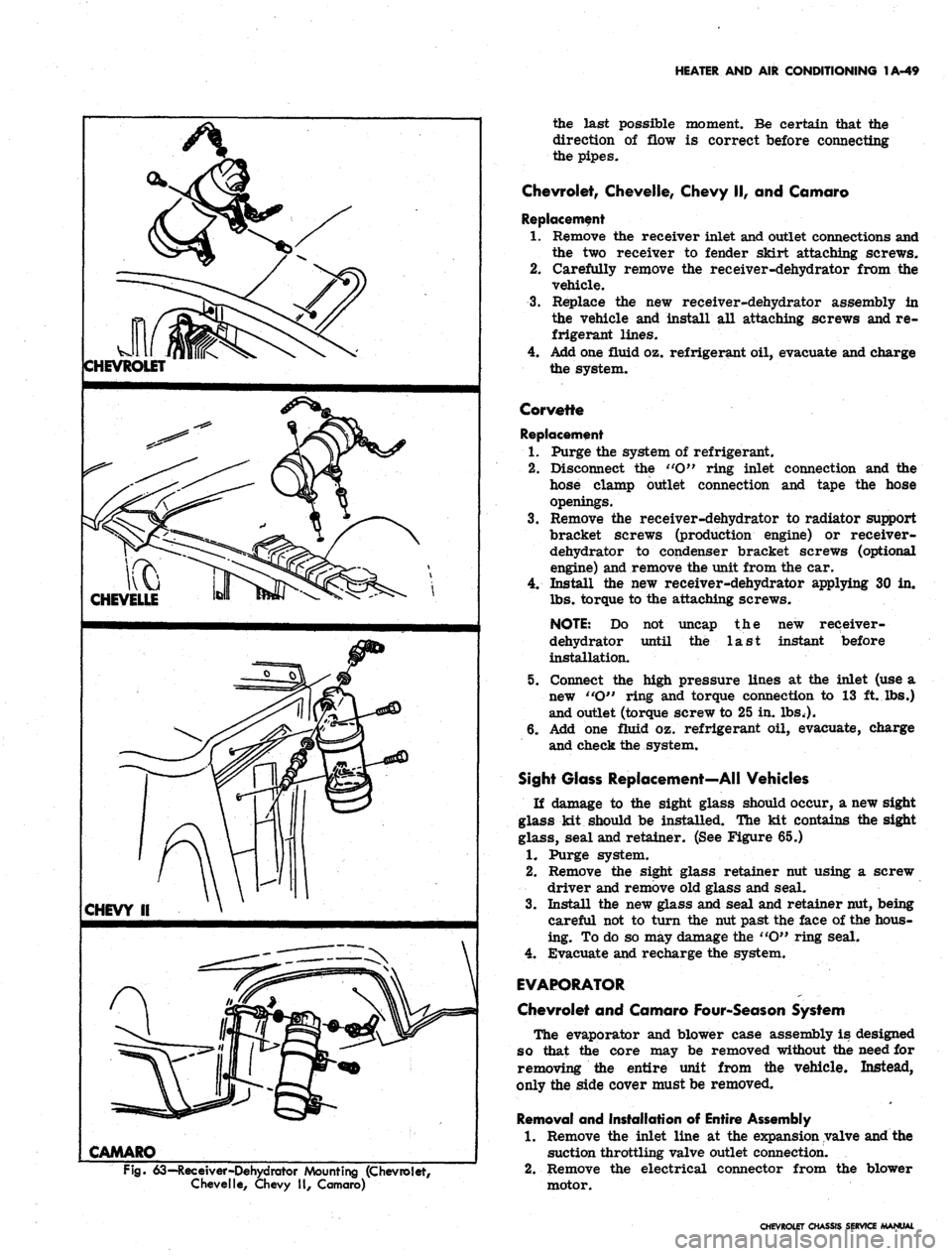
HEATER AND AIR CONDITIONING 1A-49
CHEVROLET
CHEVELLE
CHEVY II
CAMARO
the last possible moment. Be certain that the
direction of flow is correct before connecting
the pipes.
Chevrolet, Chevelle, Chevy II, and Camaro
Replacement
1.
Remove the receiver inlet and outlet connections and
the two receiver to fender skirt attaching screws.
2.
Carefully remove the receiver-dehydrator from the
vehicle.
3.
Replace the new receiver~dehydrator assembly in
the vehicle and install all attaching screws and re-
frigerant lines.
4.
Add one fluid oz. refrigerant oil, evacuate and charge
the system.
Corvette
Replacement
1.
Purge the system of refrigerant.
2.
Disconnect the "O" ring inlet
hose clamp outlet connection
openings.
3.
Remove the receiver-dehydrator to radiator support
bracket screws (production engine) or receiver-
dehydrator to condenser bracket screws (optional
engine) and remove the unit from the car.
4.
Install the new receiver-dehydrator applying 30 in.
lbs.
torque to the attaching screws.
connection and the
and tape the hose
NOTE:
Do not uncap the new receiver-
dehydrator until the last instant before
installation.
5.
2.
3.
Fig.
63—
Receiver-Dehydrator Mounting (Chevrolet,
Chevelle/ Chevy II, Camaro)
Connect the high pressure lines at the inlet (use a
new "O" ring and torque connection to 13 ft. lbs.)
and outlet (torque screw to 25 in. lbs.).
6. Add one fluid oz. refrigerant oil, evacuate, charge
and check the system.
Sight Glass Replacement-All Vehicles
If damage to the sight glass should occur, a new sight
glass kit should be installed. The kit contains the sight
glass,
seal and retainer. (See Figure 65.)
1.
Purge system.
Remove the sight glass retainer nut using a screw
driver and remove old glass and seal.
Install the new glass and seal and retainer nut, being
careful not to turn the nut past the face of the hous-
ing. To do so may damage the "O" ring seal.
4.
Evacuate and recharge the system.
EVAPORATOR
Chevrolet and Camaro Four-Season System
The evaporator and blower case assembly is designed
so that the core may be removed without the need for
removing the entire unit from the vehicle. Instead,
only the side cover must be removed.
Removal and Installation of Entire Assembly
1.
Remove the inlet line at the expansion valve and the
suction throttling valve outlet connection.
2.
Remove the electrical connector from the blower
motor.
CHEVROLET CHASSIS SERVICE MANUAL
Page 79 of 659
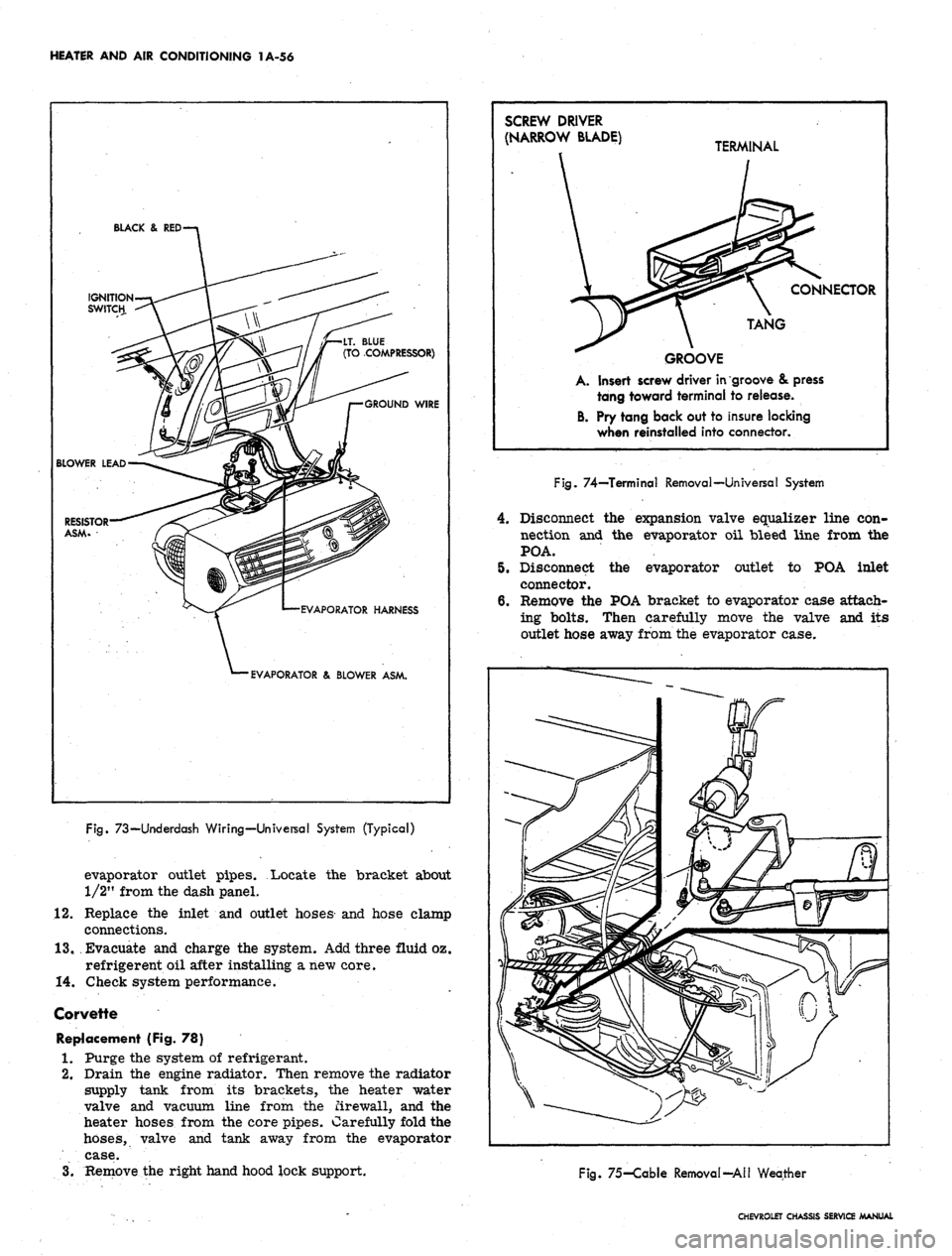
HEATER AND AIR CONDITIONING 1A-56
BLACK & RED
IGNITION—-y^****
SWITCH -"A
/
BLOWER LEAD—^^^
RESISTOR—-" \^<
ASM.
f'
i
'fu^^^^A^^^^^r"G^OUH£>
WIRE
^^
k4
^EVAPORATOR HARNESS
' EVAPORATOR & BLOWER ASM.
Fig.
73—Underdash Wiring—Universal System (Typical)
evaporator outlet pipes. Locate the bracket about
1/2" from the dash panel.
12.
Replace the inlet and outlet hoses and hose clamp
connections.
13.
Evacuate and charge the system. Add three fluid oz.
refrigerent oil after installing a new core.
14.
Check system performance.
Corvette
Replacement (Fig. 78)
1.
Purge the system of refrigerant.
2.
Drain the engine radiator. Then remove the radiator
supply tank from its brackets, the heater water
valve and vacuum line from the firewall, and the
heater hoses from the core pipes. Carefully fold the
hoses,
valve and tank away from the evaporator
case.
3.
Remove the right hand hood lock support.
SCREW DRIVER
(NARROW BLADE) T£
GROOVE
A. Insert screw driver in
tang toward terminal
B. Pry tang back out to
when reinstalled into
RMINAL
\ CONNECTOR
TANG
groove & press
to release.
insure locking
connector.
Fig.
74—Terminal Removal—Universal System
4.
Disconnect the expansion valve equalizer line con-
nection and the evaporator oil bleed line from the
POA.
5.
Disconnect the evaporator outlet to POA inlet
connector.
6. Remove the POA bracket to evaporator case attach-
ing bolts. Then carefully move the valve and its
outlet hose away from the evaporator case.
Fig.
75-Cable Removal-All Weather
CHEVROLET CHASSIS SERVICE MANUAL
Page 80 of 659
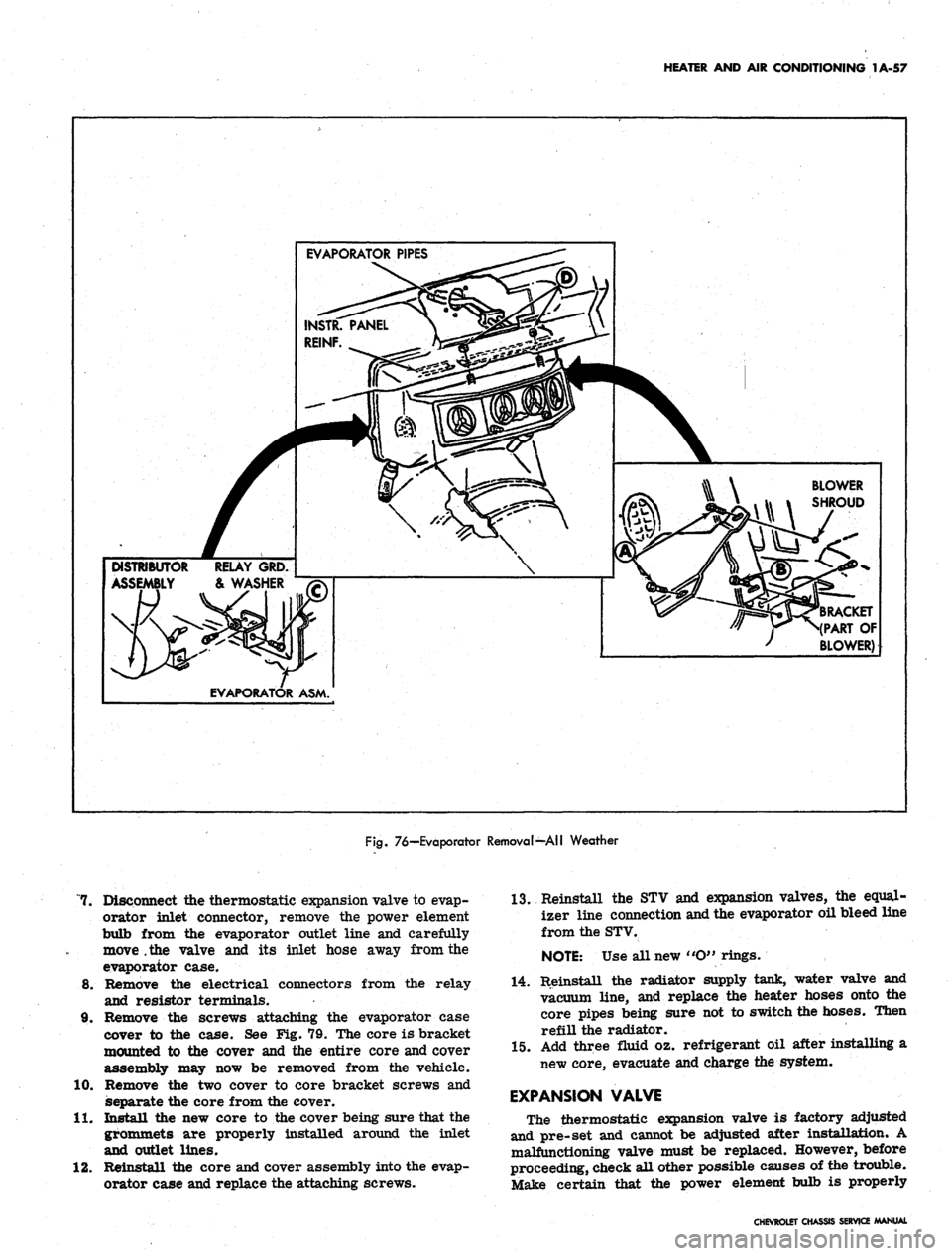
HEATER AND AIR CONDITIONING 1A-57
EVAPORATOR PIPES
DISTRIBUTOR RELAY GRD.
ASSEMBLY & WASHER
EVAPORATOR ASM.
BLOWER
SHROUD
(RACKET
(PART OF
BLOWER)
Fig.
76—Evaporator Removal—All Weather
7. Disconnect the thermostatic expansion valve to evap-
orator inlet connector, remove the power element
bulb from the evaporator outlet line and carefully
move .the valve and its inlet hose away from the
evaporator case.
8. Remove the electrical connectors from the relay
and resistor terminals.
9. Remove the screws attaching the evaporator case
cover to the case. See Fig. 79. The core is bracket
mounted to the cover and the entire core and cover
assembly may now be removed from the vehicle.
10.
Remove the two cover to core bracket screws and
separate the core from the cover.
11.
Install the new core to the cover being sure that the
grommets are properly installed around the inlet
and outlet lines.
12.
Reinstall the core and cover assembly into the evap-
orator case and replace the attaching screws.
13.
Reinstall the STV and expansion valves, the equal-
izer line connection and the evaporator oil bleed line
from the STV.
NOTE:
Use all new «O" rings.
14.
Reinstall the radiator supply tank, water valve and
vacuum line, and replace the heater hoses onto the
core pipes being sure not to switch the hoses. Then
refill the radiator.
15.
Add three fluid oz. refrigerant oil after installing a
new core, evacuate and charge the system.
EXPANSION VALVE
The thermostatic expansion valve is factory adjusted
and pre-set and cannot be adjusted after installation. A
malfunctioning valve must be replaced. However, before
proceeding, check all other possible causes of the trouble.
Make certain that the power element bulb is properly
CHEVROLET CHASSIS SERVICE MANUAL
Page 85 of 659

HEATER AND AIR CONDITIONING 1A-62
2.
Insert the evaporator assembly into the outlet case
half and mount the evaporator, thermostatic switch,
and cable to the case.
3.
Install the face plate to the case and install control
retaining nuts and knobs.
4.
Assemble the case halves and mount the evaporator
pipe clamp.
5. Install the evaporator assembly as previously
described under EVAPORATOR.
BLOWER ASSEMBLY
Four-Season System
Chevrolet and Camaro
Removal
1.
Disconnect battery ground cable.
2.
Remove the right front fender and skirt assembly.
3.
Disconnect the motor wire at the flange connector.
4.
Disconnect the rubber air cooling tube from the
motor.
5. Remove the motor to case attaching screws and re-
move the blower assembly. If the sealer acts as an
adhesive, pry the assembly carefully away from the
6. Remove the blower from the motor shaft.
Fig.
86—Blower Assembly—Four-Season (Chevrolet,
Chevelle, Camaro)
Installation
1.
Mount the blower to the motor shaft with the open end
of the blower away from the motor.
2.
Mount the assembly to the case with the attaching
screws.
3.
Connect the rubber tube and blower wire to the
motor.
4.
Replace the right front fender and skirt assembly.
5. Connect battery ground cable.
Chevelle
The blower assembly (fig. 86) is mounted to the dash
panel and contains the outside air-recirculated air
diverter door, the heating-cooling diverter door, the air
conditioning relay and resistor, the compressor actuating
switch, and the blower motor.
Replacement
1.
Disconnect the blower motor "hot" wire at the con-
nector and the ground lead on the Chevrolet.
2.
Detach the rubber cooling tube from the blower as-
sembly and remove the five bolts attaching the
blower motor to the blower assembly.
3.
Remove the motor and fan, disassemble fan from
motor and install on a new motor. If, because of
engine accessories, hoses restrict lifting the blower
assembly from the engine compartment, remove
blower from motor and lift units out separately.
Assemble replacement units under the restricting
hoses.
4.
Reinstall motor and fan into blower assembly. Re-
place cooling tube, ground wire and connect hot wire
to connector.
5. Check blower operations.
Corvette
Replacement
1.
Remove the radiator overflow tank and brackets and
pull the tank out of the way as far as the length of the
heater hose will permit.
2.
Disconnect the electrical connector and the rubber
air inlet tube from the blower motor.
3.
Remove the five blower flange to case attaching
screws and carefully remove the blower motor and
drum assembly.
4.
Remove the blower drum assembly and reinstall on
a new blower motor.
5. Replace the blower motor and drum assembly in the
case and reinstall all screws, hoses and electrical
connections.
All-Weather System
Chevy II
Removal
Under the Hood
1.
Purge the refrigerant from the system.
2.
Drain the radiator.
3.
Remove the refrigerant hoses at the evaporator
pipes.
4.
Remove the evaporator pipe clamp and grommet.
5. Remove three nuts from the blower case studs which
pass through the firewall.
6. Remove heater hoses from core tubes.
CHEVROLET CHASSIS SERVICE MANUAL
Page 88 of 659

HEATER AND AIR CONDITIONING 1A-65
Fig.
92—Chevrolet Four-Season Ducts
Installation
Reverse
assembly.
the removal procedure to reinstall the duct
Left Outlet Duct
Removal
1.
Remove the two parking brake lever bracket to
dash brace attaching screws and move the lever and
cable so they will not interfere with the duct
removal.
2.
Remove the screw and lock washer attaching the duct
outer bracket to the hinge pillar support.
3.
Remove the screws and lock washers attaching the
duct assembly to the dash brace bracket.
4.
Carefully pull the outer end of the duct downward,
detaching the courtesy light from its bracket.
5. Loosen the screws clamping the outlet duct to dis-
tributor assembly flexible tubing at the outlet duct.
The outlet duct may now be removed from beneath
the instrument panel.
6. The duct extension assembly and the deflector as-
sembly may be removed, if desired, as seen in
Figure 95.
Installation
The duct assembly is installed by reversing the re-
moval instructions.
Center Outlet Duct
Removal
1.
Remove the right and left console trim panels.
2.
Remove the radio receiver.
3.
Remove the electric clock.
4.
Remove the knobs, nuts and bezels from the two
air conditioning controls above the clock, AIR COND.
PULL and COLD IN-HOT PULL.
5. Carefully pull the outlet duct and control cables
loose from the rear of the center console and work
it down and out from under the dash. The left hand
control cable runs through the left hand flexible
tubing and may be left in the tubing after it is dis-
engaged from the duct. The right hand control cable
must also be pulled from the duct assembly as the
duct is removed.
6. The center deflector barrel assembly may now be
removed if necessary. Snap off the hairpin clips to
remove the barrel and spacer washers.
Installation
Reverse the removal procedure for installation.
AIR DISTRIBUTOR ASSEMBLY
Removal
1.
Drain the cooling system radiator.
2.
Remove the heater hoses from the core pipes and
remove the cover attaching nuts and cover surround-
ing the core pipes.
3.
Remove the glove compartment assembly and the
glove compartment door.
NOTE:.
See "Section 1 - Body" for removal
and installation of body items.
4.
Remove the right kick pad.
5. Remove the right and left center console trim panels.
6. Remove the radio receiver assembly.
7. Remove the defroster duct.
CHEVROLET CHASSIS SERVICE MANUAL
Page 90 of 659

HEATER AND AIR CONDITIONING 1A-67
Fig.
94—Camaro Four-Season Ducts
Heater and Air Distributor Assembly
Removal
rfooo
1.
Disconnect battery ground cable.
2.
Drain radiator (do not purge refrigerant system).
3.
Disconnect all connectors attached to the Comfortron
wiring harness which are on the engine side of the
firewall. Push the wiring harness grommet through
the firewall to the rear.
4.
Disconnect the four vacuum hoses coming from the
underdash through the large firewall grommet. Push
the hose grommet through the firewall to the rear.
5.
Remove the nuts from the heater and air distributor
case studs which project through the firewall from
the dash side.
6. Disconnect the heater hoses from the core tubes.
Under Dash
1.
Remove glove box assembly.
2.
Remove the dash center face plate, ash tray assem-
bly, and any radio and/or tape equipment.
3.
Remove the Comfortron control assembly mounting
screws and lower the control unit.
4.
Remove the vacuum line from the kick pad valve
diaphragm.
5.
Disconnect all harness connectors between the Com-
fortron harness and the rest of the dash wiring.
6. Remove the air distributor duct which supplies the
dash outlets.
7.
Remove the screws attaching the heater and air
distributor to the firewall.
8. Pull the assembly rearward then down to remove
from the dash. Pull the Comfortron wiring harness
and vacuum hose assembly through the firewall.
Installation
1.
Place the entire case assembly with wiring, vacuum
hoses,
and control assembly into the car on the floor.
2.
Pass the underhood wiring harness and vacuum hose
harness as far as possible through the appropriate
firewall holes.
3.
Lift the assembly up into position and pass the case
studs through the firewall mounting holes. Attach
the case to the firewall with the mounting screws.
4.
Mount the dash outlet air distributor duct to the face
of the case.
CHEVROLET CHASSIS SERVICE MANUAL
Page 96 of 659
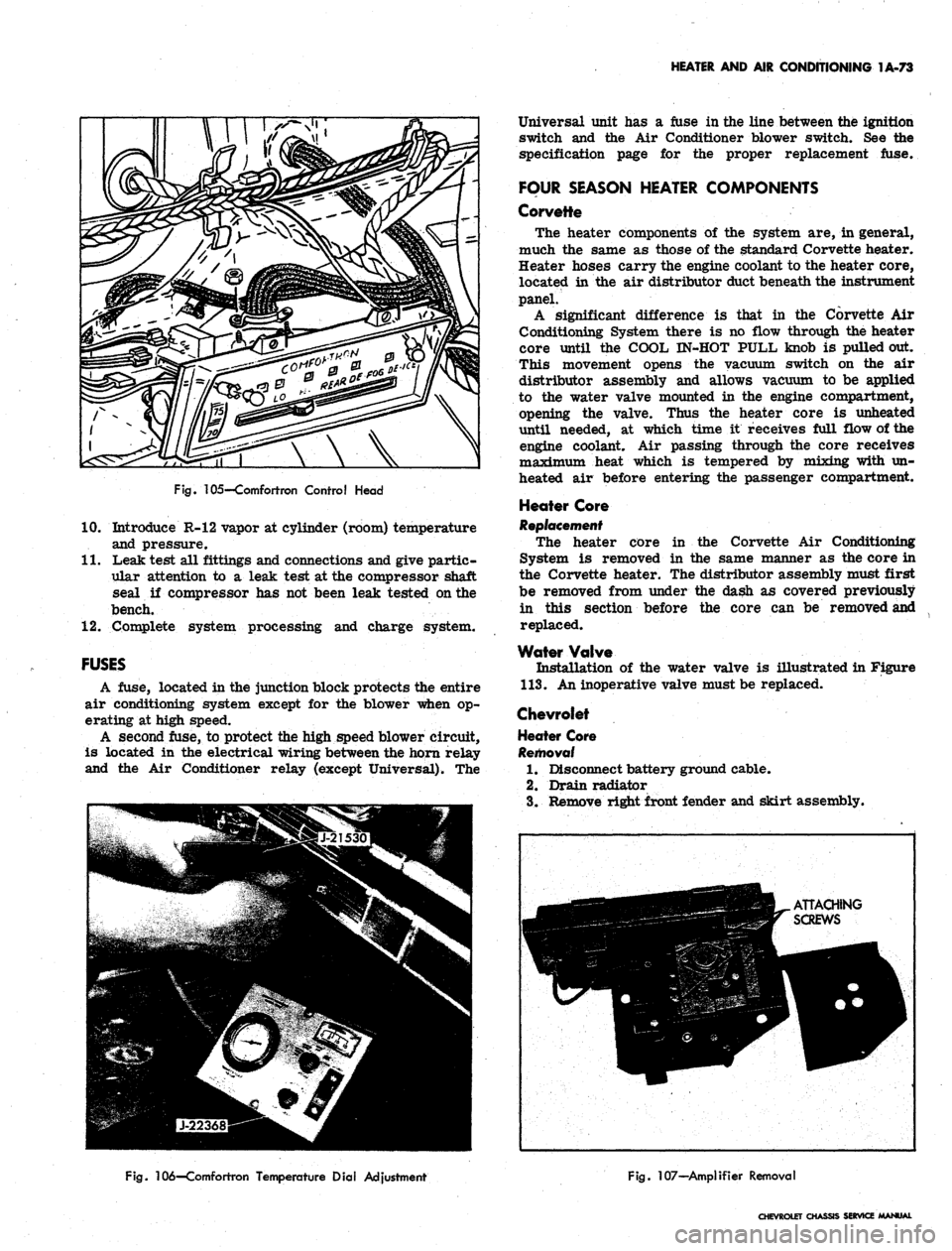
HEATER AND AIR CONDITIONING 1A-73
Fig.
105—Comfortron Control Head
10.
Introduce R-12 vapor at cylinder (room) temperature
and pressure.
11.
Leak test all fittings and connections and give partic-
ular attention to a leak test at the compressor shaft
seal if compressor has not been leak tested on the
bench.
12.
Complete system processing and charge system.
FUSES
A fuse, located in the junction block protects the entire
air conditioning system except for the blower when op-
erating at high speed.
A second fuse, to protect the high speed blower circuit,
is located in the electrical wiring between the horn relay
and the Air Conditioner relay (except Universal). The
Universal unit has a fuse in the line between the ignition
switch and the Air Conditioner blower switch. See the
specification page for the proper replacement fuse.
FOUR SEASON HEATER COMPONENTS
Corvette
The heater components of the system are, in general,
much the same as those of the standard Corvette heater.
Heater hoses carry the engine coolant to the heater core,
located in the air distributor duct beneath the instrument
panel.
A significant difference is that in the Corvette Air
Conditioning System there is no flow through the heater
core until the COOL IN-HOT PULL knob is pulled out.
This movement opens the vacuum switch on the air
distributor assembly and allows vacuum to be applied
to the water valve mounted in the engine compartment,
opening the valve. Thus the heater core is unheated
until needed, at which time it receives full flow of the
engine coolant. Air passing through the core receives
maximum heat which is tempered by mixing with un-
heated air before entering the passenger compartment.
Heater Core
Replacement
The heater core in the Corvette Air Conditioning
System is removed in the same manner as the core in
the Corvette heater. The distributor assembly must first
be removed from under the dash as covered previously
in this section before the core can be removed and
replaced.
Water Valve
Installation of the water valve is illustrated in Figure
113.
An inoperative valve must be replaced.
Chevrolet
Heater Core
Removal
1.
Disconnect battery ground cable.
2.
Drain radiator
3.
Remove right front fender and skirt assembly.
Fig.
106—Comfortron Temperature Dial Adjustment
Fig.
107—Amplifier Removal
CHEVROLET CHASSIS SERVICE MANUAL
Page 97 of 659
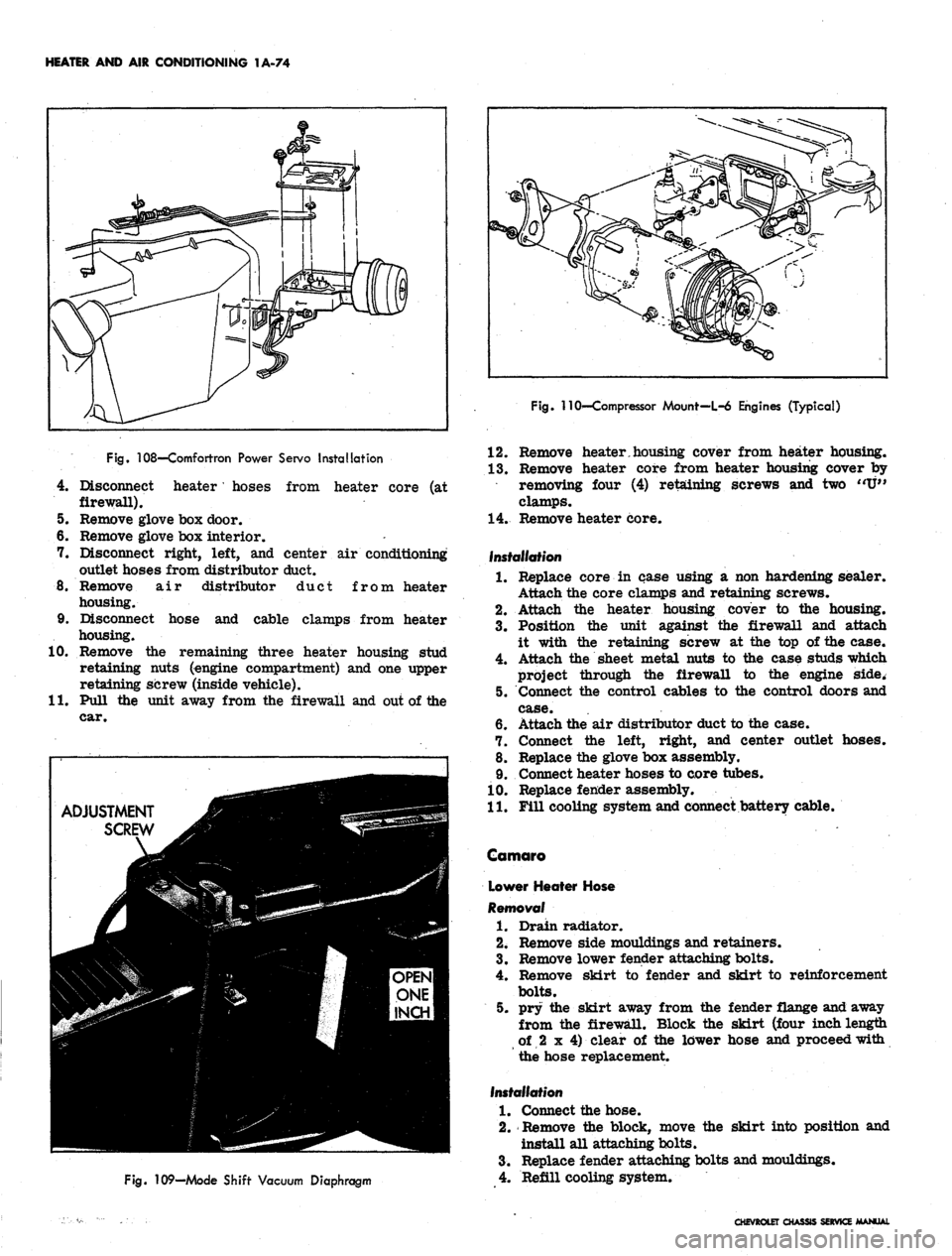
HEATER AND AIR CONDITIONING 1A-74
Fig.
108—Comfortron Power Servo Installation
4.
Disconnect heater' hoses from heater core (at
firewall).
5. Remove glove box door.
6. Remove glove box interior.
7. Disconnect right, left, and center air conditioning
outlet hoses from distributor duct.
8. Remove air distributor duct from heater
housing.
9. Disconnect hose and cable clamps from heater
housing.
10.
Remove the remaining three heater housing stud
retaining nuts (engine compartment) and one upper
retaining screw (inside vehicle).
11.
Pull the unit away from the firewall and out of the
car.
ADJUSTMENT
SCREW
Fig.
109—Mode Shift Vacuum Diaphragm
Fig. 110'—Compressor Mount—L-6 Engines (Typical)
12.
Remove heater.housing cover from heater housing.
13.
Remove heater core from heater housing cover by
removing four (4) retaining screws and two "U"
clamps.
14.
Remove heater core.
Installation
1.
Replace core in case using a non hardening sealer.
Attach the core clamps and retaining screws.
2.
Attach the heater housing cover to the housing.
3.
Position the unit against the firewall and attach
it with the retaining screw at the top of the case.
4.
Attach the sheet metal nuts to the case studs which
project through the firewall to the engine side.
5. Connect the control cables to the control doors and
case.
6. Attach the air distributor duct to the case.
7. Connect the left, right, and center outlet hoses.
8. Replace the glove box assembly.
9. Connect heater hoses to core tubes.
10.
Replace fender assembly.
11.
Fill cooling system and connect battery cable.
Camaro
Lower Heater Hose
Removal
1.
Drain radiator.
2.
Remove side mouldings and retainers.
3.
Remove lower fender attaching bolts.
4.
Remove skirt to fender and skirt to reinforcement
bolts.
5. pry the skirt away from the fender flange and away
from the firewall. Block the skirt (four inchlengtti
of 2 x 4) clear of the lower hose and proceed with
the hose replacement.
Installation
1.
Connect the hose.
2.
Remove the block, move the skirt into position and
install all attaching bolts.
3.
Replace fender attaching bolts and mouldings.
4.
Refill cooling system.
CHEVROLET CHASSIS SERVICE MANUAL